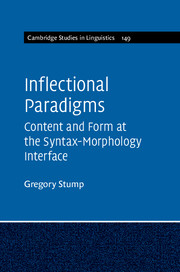Book contents
- Frontmatter
- Dedication
- Contents
- List of figures
- List of tables
- Acknowledgements
- List of abbreviations
- List of symbols and operators
- Introduction
- 1 What are inflectional paradigms?
- 2 Canonical inflectional paradigms
- 3 Morphosyntactic properties
- 4 Lexemes
- 5 Stems
- 6 Inflection classes
- 7 A conception of the relation of content to form in inflectional paradigms
- 8 Morphomic properties
- 9 Too many cells, too few cells
- 10 Syncretism
- 11 Suppletion and heteroclisis
- 12 Deponency and metaconjugation
- 13 Polyfunctionality
- 14 A theoretical synopsis and two further issues
- References
- Index
1 - What are inflectional paradigms?
Published online by Cambridge University Press: 18 December 2015
- Frontmatter
- Dedication
- Contents
- List of figures
- List of tables
- Acknowledgements
- List of abbreviations
- List of symbols and operators
- Introduction
- 1 What are inflectional paradigms?
- 2 Canonical inflectional paradigms
- 3 Morphosyntactic properties
- 4 Lexemes
- 5 Stems
- 6 Inflection classes
- 7 A conception of the relation of content to form in inflectional paradigms
- 8 Morphomic properties
- 9 Too many cells, too few cells
- 10 Syncretism
- 11 Suppletion and heteroclisis
- 12 Deponency and metaconjugation
- 13 Polyfunctionality
- 14 A theoretical synopsis and two further issues
- References
- Index
Summary
In this chapter, I examine the defining characteristics of inflectional paradigms (Section 1.1). A central issue in morphological theory is whether inflectional paradigms have theoretical significance. According to paradigm-based theories of inflection (e.g. those of Stump 2001, Blevins 2006, Ackerman, Blevins and Malouf 2009, Brown and Hippisley 2012), the definition of a language's inflectional morphology makes essential reference to the structure of paradigms; but according to morpheme-based theories (e.g. those of Halle and Marantz 1993, Bobaljik 2002, Müller 2002), paradigms are instead merely an epiphenomenal effect of principles of morpheme combination, having no essential role in the definition of a language's inflectional morphology. I compare the morpheme-based perspective (Section 1.2) with the paradigm-based approach (Section 1.3); of these, only the latter is compatible with two central hypotheses for which I argue in this book: the irreducibility hypothesis and the interface hypothesis.
What is an inflectional paradigm?
In a language with inflectional morphology, morphosyntactic properties are grammatical properties to which the language's syntax and morphology are both sensitive. In French, for example, the gender properties “feminine” and “masculine” and the number properties “singular” and “plural” are morphosyntactic properties. On one hand, syntactic agreement relations are sensitive to contrasts in gender and number; thus, the noun phrase in (1) is grammatical because its constituents agree in gender and number, and the noun phrase in (2) is ungrammatical because its constituents fail to agree in this way. At the same time, rules of inflectional morphology are likewise sensitive to contrasts in gender and number; thus, the French adjective national has distinct feminine and masculine forms in the plural (feminine plural nationales /nasjɔnal/, masculine plural nationaux /nasjɔno/), while in the singular, the feminine and masculine forms of national are distinguished orthographically though not phonologically (feminine singular nationale, masculine singular national, both /nasjɔnal/).
(1) les musées nationaux
the.pl museum.masc.pl national.masc.pl
‘the national museums’
(2) *le musées nationales
the.masc.sg museum.masc.pl national.fem.pl
Some morphosyntactic properties have specific semantic correlates; thus, noun phrases with singular reference tend to be headed by nouns in their singular form. But morphosyntactic properties may also lack any obvious semantic correlate; thus, while noun phrases with female reference may tend to be headed by feminine nouns, some feminine nouns (e.g. recrue ‘recruit,’ sentinelle ‘sentinel’) ordinarily have male reference and others – in fact, the large majority – fail to refer specifically to either sex (souris ‘mouse,’ table ‘table,’ invention ‘invention,’ and so on).
- Type
- Chapter
- Information
- Inflectional ParadigmsContent and Form at the Syntax-Morphology Interface, pp. 8 - 30Publisher: Cambridge University PressPrint publication year: 2015



